Praying Mantis Care 101 & Why You Should Get Them
Chinese mantises are also fascinating creatures to observe in the garden. They are known for their distinctive appearance, with long, slender bodies and large, grasping forelegs. Watching them hunt and capture their prey can be a thrilling sight.
- Praying Mantis Basics & Why You Should Get Them:
- Praying Mantis Feeding Habits
- Are Praying Mantises Good for Your Garden?
- Praying Mantises Habitat
- Praying Mantis Care 101
- Can You Buy Praying Mantises For Sale?
- Praying Mantis Egg Sacs (Ootheca)
- Praying Mantises As Pets
Video: Benefits of Praying Mantises in the Garden
Who Should Get Them?
Praying mantises are not ideal for all gardeners but in some situations they can be quite advantageous as a form of pest control.
Praying Mantis Basics +
Why You Should Get Them:
Praying Mantis Feeding Habits
Praying mantises are carnivorous insects, known for their distinctive hunting behavior. They're ambush predators, meaning that they lie in wait for their prey and then attack it suddenly and with great speed. Mantises typically use their front legs to grasp and hold onto their prey, while using their sharp mandibles to deliver a fatal bite. They may also use their front legs to strike at their prey with lightning-fast movements.
Once a praying mantis has caught its prey, it will typically devour it on the spot, using its powerful mandibles to tear the flesh and eat it. Praying mantises are known for their voracious appetites and can eat a significant amount of food in a single day.
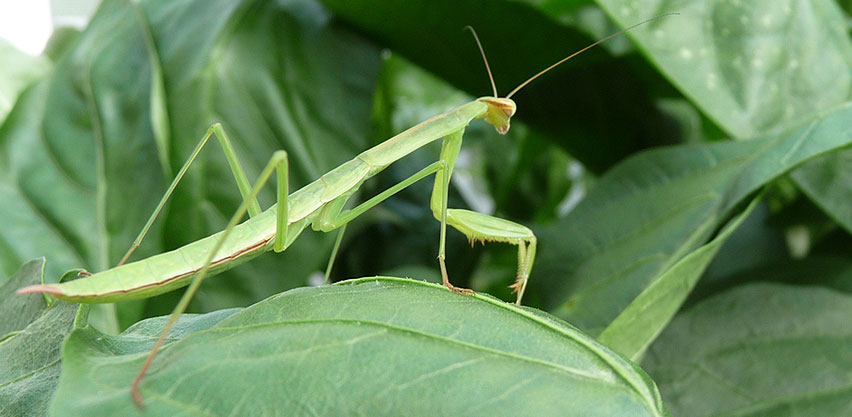
This praying mantis sits on a plant leaf waiting to pounce on any prey that it spots.
Praying mantises feed on a wide variety of insects and other small creatures, including moths, crickets, grasshoppers, flies and spiders. However, praying mantises are also known for their ability to catch and kill prey that is much larger than themselves. They've been know to eat fish, small lizards, frogs and even small birds!
After feeding, praying mantises will often groom themselves, cleaning off any remaining bits of food from their bodies. They may also use this time to rest and digest their meal before continuing to hunt for more prey.
Are Praying Mantises Good for Your Garden?
BENEFITS OF PRAYING MANTISES: Yes, mantises are generally considered beneficial insects for gardens. This even includes Chinese mantises, which are naturalized species in the US. As natural predators, mantises feed on a wide variety of invertebrates, including moths, grasshoppers, crickets, flies, true bugs and beetles. Mantises offer benefits by eating these pests which helps to control their populations. This, in turn, prevents damage to your plants while adding to the biodiversity of your space.
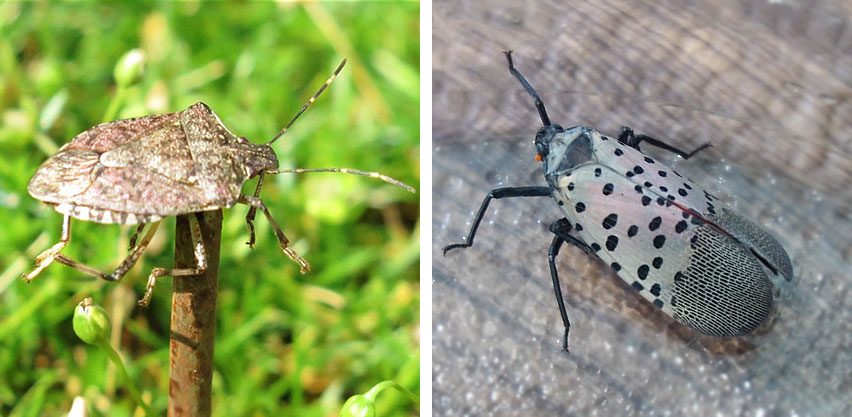
Stink bugs & spotted lanternflies are common insect pests which are eaten by Chinese mantises.
WHY YOU SHOULD GET PRAYING MANTISES: Chinese mantises have demonstrated the noteworthy potential as way means for controlling invasive insect pests. It was been well documented that Chinese mantises will eat the highly destructive brown marmorated stink bug (BMSB). Those insect pests causes millions of dollars of damage to crops every year. More recently, the invasive spotted lanternfly has been accidentally to North America introduced. As it continues to swarm across the United States, it has threatened both native trees and agricultural crops. The Chinese mantises has been shown to feed upon this pest as well.
However, it's important to note that while mantises can be beneficial to your garden, they're not a silver bullet for pest control. As generalist predators, mantises eat both harmful and beneficial insects including honey bees and butterflies. For this reason, they have limited value as biological-control agents. Even still, if you discover one in your garden it's recommended to leave it undisturbed. You can expect that it will consume at least some insect pests.
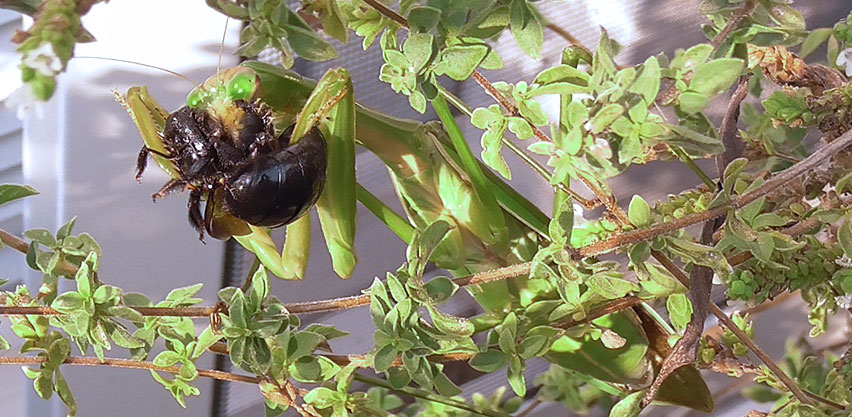
Much like spiders, praying mantises eat a variety of creatures, including destructive pests and also beneficial pollinators.
Praying Mantises Habitat
Praying mantises are found in various habitats across the world, including tropical rainforests, deserts, grasslands, and temperate forests. The specific natural habitat of a praying mantis depends on its species. In general, praying mantises prefer to live in warm and humid environments, but they can also adapt to cooler climates. They can be found in Asia, Africa, Europe, North America, South America and Australia.
Some species of praying mantis prefer to live in trees or shrubs, while others prefer to live on the ground or in other low vegetation. Some species are found near water bodies such as rivers, ponds, or streams. The natural habitats of praying mantises are typically characterized by the availability of suitable prey and the presence of vegetation for them to camouflage themselves in.
The praying mantises found in the United States inhabit a variety of natural habitats, ranging from forests and grasslands to agricultural fields and suburban gardens. Some of the common US species of praying mantis include the Carolina mantis, the Chinese mantis, and the European mantis.
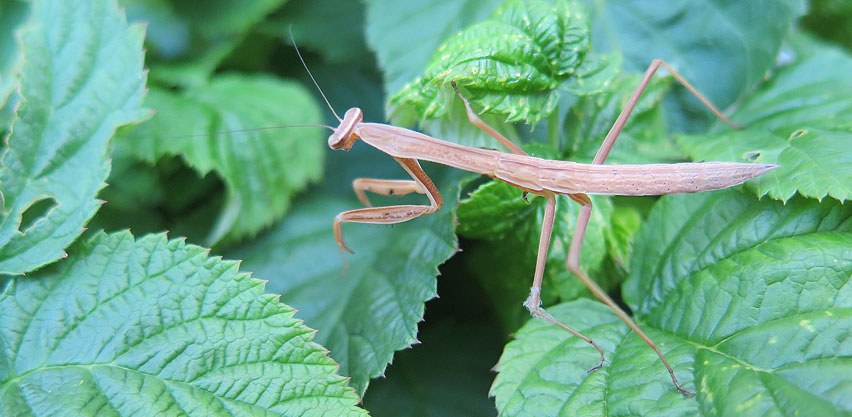
The Chinese mantis is a common site in many home gardens across the United States.
The Carolina mantis is native to the southeastern United States and typically inhabits grasslands, meadows, and forest edges. The Chinese mantis is now found throughout much of the United States. It's commonly found in gardens, orchards and other areas with vegetation. Another non-native mantis, the European mantis, is found primarily in the northeastern part of the country.
In general, praying mantises in the United States prefer warm and humid environments with plenty of vegetation for them to camouflage themselves in. They can be found in areas with an abundance of prey, including insects such as crickets, moths, and grasshoppers.
Praying Mantis Care 101
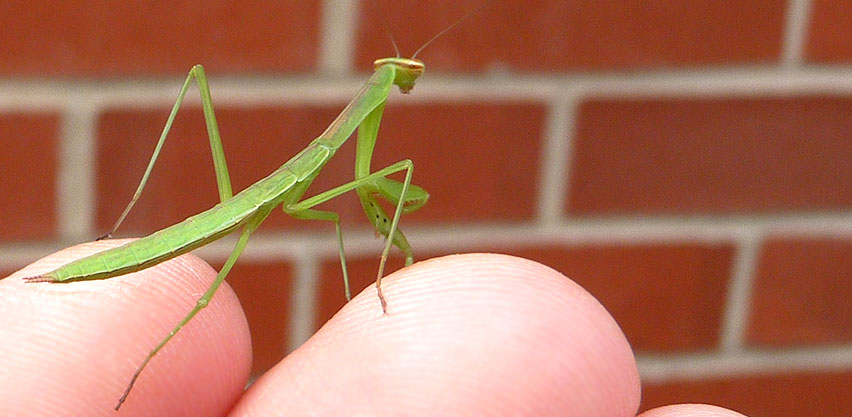
Praying mantises are fun creatures, which not not hard to care for, if you know what to do.
Can You Buy Praying Mantises For Sale?
It's possible to buy praying mantises for sale in many places across the US. Some people might want to keep them as pets. Gardeners might be interested in using them as an organic form of pest control. This might be especially desirable as a way to combat invasive pests like stink bugs or spotted lanternflies.
WHERE CAN YOU FIND PRAYING MANTISES? You might be able to find live mantises at a local garden store. But the much more common means of acquiring mantises is by purchasing unhatched egg cases. In addition to buying these locally, praying mantis egg cases can be bought online through both specialty pest control stores as well as Amazon and Ebay.

Rather than buying a couple live mantises, buying an egg case can yield lots of mantises!
Overall, buying praying mantises for sale may seem like a unique and interesting idea. But potential buyers should carefully consider the legal, ethical, care and compatibility issues before making a purchase. There are several factors to be aware of:
LEGAL ISSUES: It may be illegal to buy or sell praying mantises in some states or countries. Buyers should check with their local wildlife or agriculture department to determine if it's legal to own or sell them.
ETHICAL CONCERNS: Praying mantises are often captured in the wild and sold as pets or for use in gardening as a form of pest control. This can lead to a decline in wild populations of praying mantises, which can have negative impacts on the ecosystem. Additionally, some conservationists are opposed to the distribution of non-native US species like the European and Chinese mantises.
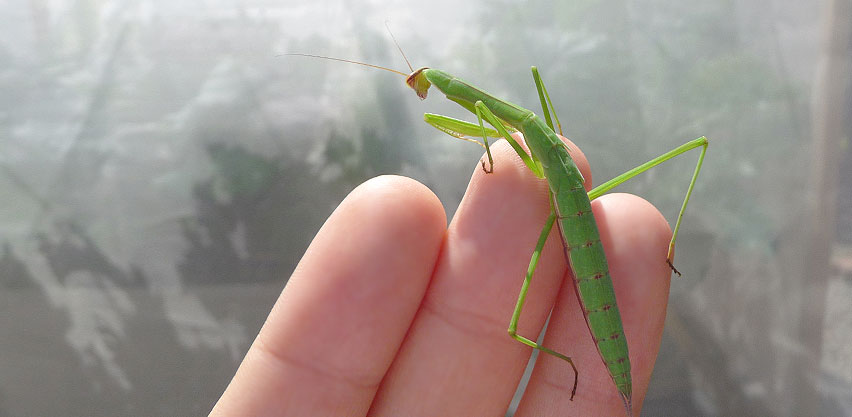
Some conservationists bitterly oppose the use of non-native Chinese mantises in American gardens.
CARE REQUIREMENTS: Praying mantises have specific care requirements, and many buyers may not be prepared to provide the proper care for them. If they are not provided with the proper food, humidity, temperature, and enclosure size, they can become stressed and may not survive.
PREDATORY NATURE: When released outdoors, mantises might help in the garden. But some gardens might not benefit from their introduction. Praying mantises can be very helpful for fruit and vegetable gardeners. But native pollinator gardens might not benefit from the introduction of mantises. This is true for both native and non-native species. All mantises have the potential to impact pollinator populations such as bees and butterflies.
Praying Mantis Egg Sacs (Ootheca)
Praying mantises are a popular garden predator due to their voracious appetite for insects. For this reason some gardeners may want to introduce mantises to their gardens. Rather than trying to find live insects, I recommend purchasing praying mantis egg sacs, known as oothecae. Each ootheca may contain HUNDREDS of baby mantises so you only need a couple for a small yard.
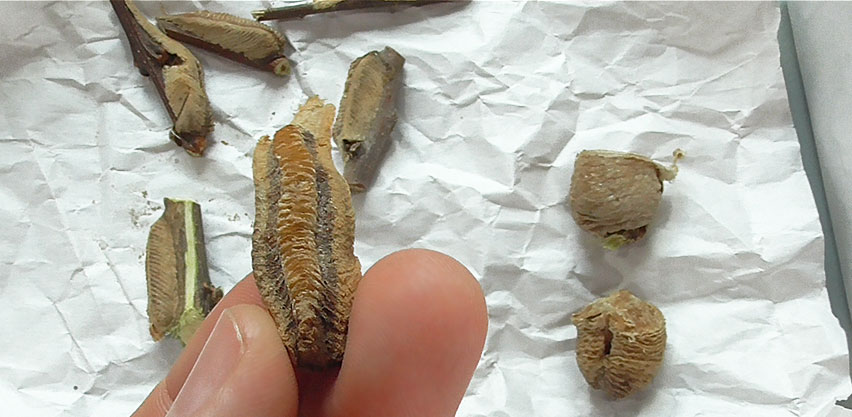
These oothecae were purchased online: Carolina mantis egg cases on the left, Chinese mantis on right.
Here are some important things that gardeners should know about praying mantis egg sacs:
BUYING EGG CASES: Mantis oothecae can be purchased online or from gardening stores. Praying mantis egg sacs are sold by several online retailers and in some gardening stores. They're often sold in small, sealed containers to keep them safe during shipping. I've found that Ebay has been a great resource for buying viable oothecae and an affordable price.
TIMING IS CRUCIAL: You should buy and release your egg cases by the time Spring has begun. Praying mantis egg sacs will remain dormant and unhatched as long as they remain cold. They can withstand cold Winter temperatures, well below freezing. However, in the early Spring, once temperatures consistently exceed 50°F (10°C), this will trigger the eggs to hatch. At this time of year, there will be an abundance of insect prey available for the young mantises to feed on. This is the perfect time. Do not try to buy and release egg cases in the Summer or even late Spring. This will not support their natural life cycle.
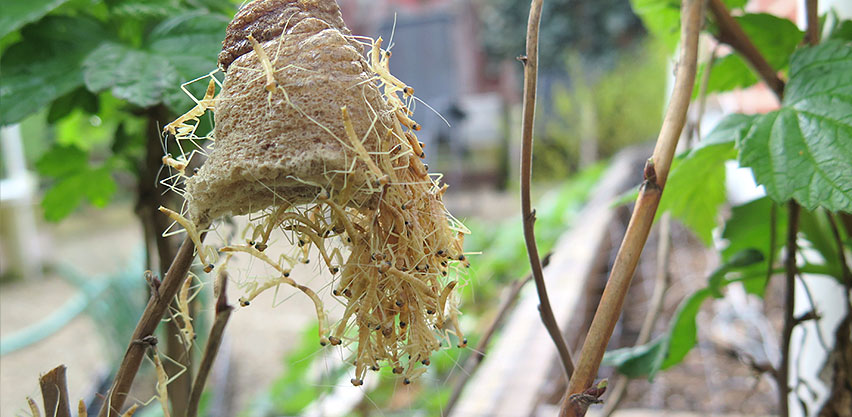
You only need a couple of mantis egg cases to get hundreds of mantises!
IT ONLY TAKES A COUPLE: Mantis egg sacs can produce hundreds of baby mantises. Depending on the species of mantis, each ootheca can produce between 100 to 400 baby mantises. These tiny mantises will emerge from the egg sacs in search of food and will continue to grow and mature throughout the spring and summer. It might seem like a lot, but don't worry, the mantis population always has a way of thinning out as they grow larger. You won't ever get overwhelmed.
PLACEMENT: Egg sacs should be placed in a sheltered location. When releasing praying mantis egg sacs in the garden, it's best to place them in a spot where they will be protected from the elements. I typically attach them to the branches of a dense shrub, small tree or woody perennial. If the plants tends to get early Spring aphid infestations, this will provide a perfect food source for the baby mantises.
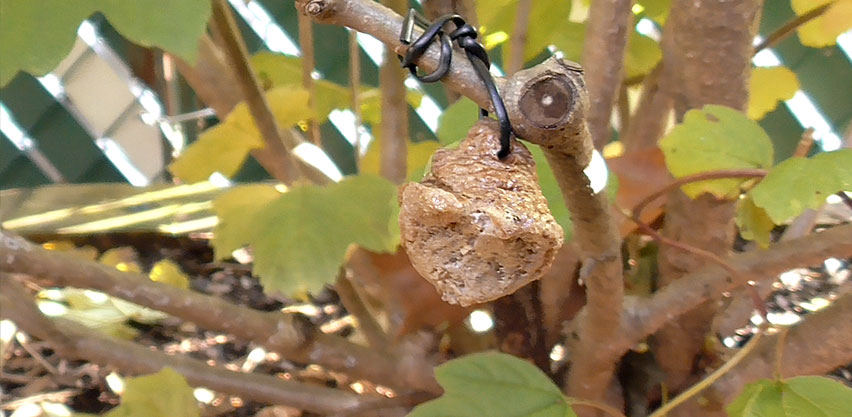
By tying this Chinese mantis egg case to a small branch of a shrub, the hatchlings will have good shelter when they emerge.
AVOID PESTICIDES: Praying mantises are sensitive to pesticides, so it's important to avoid using them in the garden if you want to encourage a healthy population of mantises. Additionally, pesticides can harm other beneficial insects and disrupt the natural balance of the ecosystem.
Praying Mantises As Pets:

Praying mantises can excite the imagination and are suitable pets for children!
Praying mantises are captivating creatures to keep as pets, but they do require specific care to ensure they stay healthy and thrive. If you're interested in keeping a praying mantis, here are some things to consider. Properly caring for your mantis will ensure its health and well-being:
HOUSING: Praying mantises need a spacious enclosure that provides good ventilation. A glass or plastic terrarium with a secure lid is a good option. A mesh or screen lid is ideal, as it allows for air circulation and prevents the mantis from climbing out. The enclosure should be tall enough to accommodate the mantis' height and wide enough for it to move around. That means it should be at least three times the length of the mantis. It would be good to include some branches or twigs for climbing.
SUBSTRATE: A substrate, such as sphagnum moss, vermiculite or coir, is necessary to maintain humidity and absorb moisture. Lay down a couple inches of this matter as a bedding at the bottom of the terrarium. This also provides a surface for the mantis to grip onto while molting.
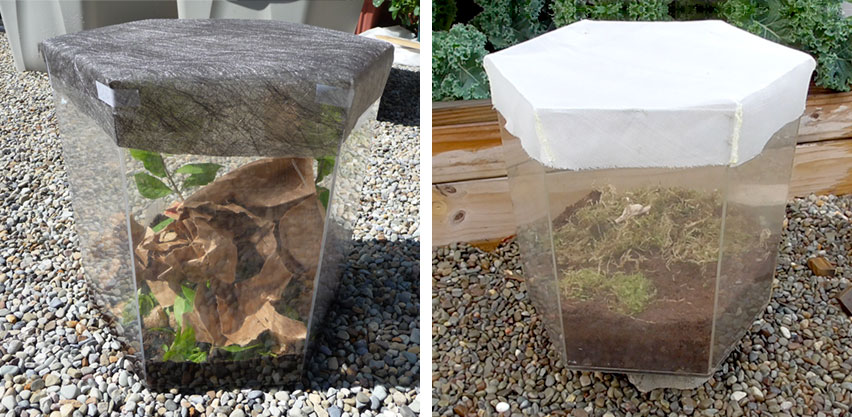
A piece of landscape fabric or fine mesh netting is a good covering for this praying mantis terrarium.
TEMPERATURE: Praying mantises are ectothermic, which means they rely on their environment to regulate their body temperature. The ideal temperature range for most species is between 75-85°F during the day and 60-70°F at night.
HUMIDITY: Maintaining proper humidity is essential for a praying mantis' health. A misting bottle can be used to provide moisture, but be careful not to oversaturate the enclosure or create standing water. The humidity level should be between 40% and 60%.
DIET: Praying mantises are carnivorous and feed on live insects, such as crickets, fruit flies, flies, caterpillars, and moths. They need a varied diet and should be offered a steady supply of prey that is appropriately sized for their body.
LIGHTING: While praying mantises don't require UVB lighting like reptiles, they do need a light source to establish a day/night cycle. A low-wattage bulb, placed on a timer, can be used to provide ambient light.

Rather than gripping a mantis, I simply allow it to walk on my hand.
HANDLING: Praying mantises can be handled, but it's important to do so gently and infrequently. Their delicate bodies can be easily injured, so it's best to observe them from outside the enclosure when possible.
LIFESPAN: Praying mantises have a relatively short lifespan, ranging from a few months to a year. This is something to keep in mind before deciding to keep one as a pet. In captivity, most common US mantises should last about 12 months, although the Giant Asian Praying Mantis can live for 24 months.
SPECIES-SPECIFIC CARE: Different species of praying mantis have slightly different care requirements. Be sure to do your research and ensure you are providing the appropriate care for your specific mantis species.
LEGAL CONSIDERATIONS: Some species of praying mantis are protected by law, so it's important to ensure that you can legally keep a mantis as a pet in your area.
Compared to other types of common pets, mantises may be short lived. Even still, keeping a praying mantis as a pet can be a exciting and rewarding experience. They're low-maintenance pets that can be fascinating to observe.



